
views
Look at the number printed on each dollar bill.
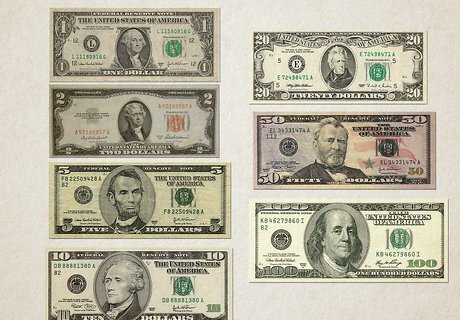
Every US bill has a number in each corner to represent its value. The value is also printed in words across the bottom of the bill. For example, a 20 dollar bill will have the number 20 in all corners, and the bottom will say “Twenty Dollars.” Currently, the US only prints bills worth $1, $2, $5, $10, $20, $50, and $100. A $1 bill is commonly called a “single.” Bills worth $2 are rare. The other 6 bills are the ones you’ll see most frequently. Even though the US doesn’t print bills larger than $100 anymore, those bills are still legal to use if you come across them.
Read the value on the backs of coins.
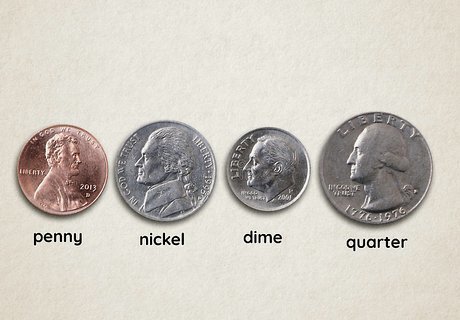
All US coins have their value printed on the back. Pennies say “one cent,” nickels say “five cents,” dimes say “one dime,” and quarters say “one quarter.” Remember that the value (the number of cents a coin represents) determines what the coin is worth, and not its size. A penny is worth 1 cent, so it takes 100 pennies to make 1 dollar. Pennies are copper in color and are the second-smallest coin. A nickel is worth 5 cents, and it takes 20 nickels to make 1 dollar. Nickels are silver and are larger than pennies. A dime is worth 10 cents, and it takes 10 dimes to make 1 dollar. Dimes are silver and are the smallest of all the coins. A quarter is worth 25 cents, so it takes 4 quarters to make 1 dollar. Quarters are silver and they are the biggest of the coins.
Sort your bills and coins by value.
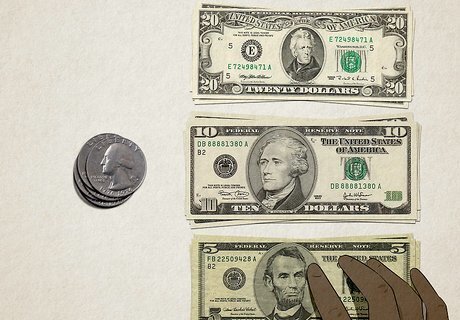
Make piles or stacks of like coins and bills to speed up your counting. Eyeball your coins—if you only have a few, sort them out by type. If you have lots of coins, make piles that are each equal to 1 dollar for easy counting. Turn or flip paper bills so they all face the same direction. Lay your money on a flat, clean surface. This will make stacking easier and keep your piles separate and organized.
Calculate the value of your coins.
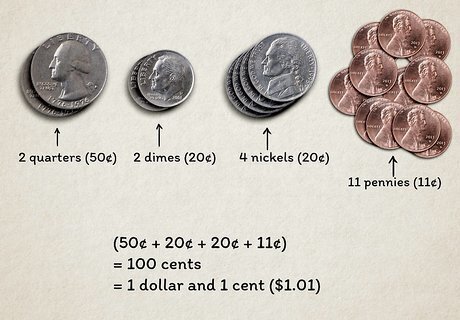
Add up the value of each coin stack, then add the stacks together. Start with the highest-value coins you have (your stack of quarters), then work towards the lowest-value ones (your stack of pennies). Every 100 cents you count makes 1 dollar. For example: Pretend you have stacks of 2 quarters (50¢), 2 dimes (20¢), 4 nickels (20¢), and 11 pennies (11¢). When you add these stacks together, you get a total of 101¢. Since 100 cents makes 1 dollar, you have 1 dollar and 1 cent ($1.01).
Add bill values together.
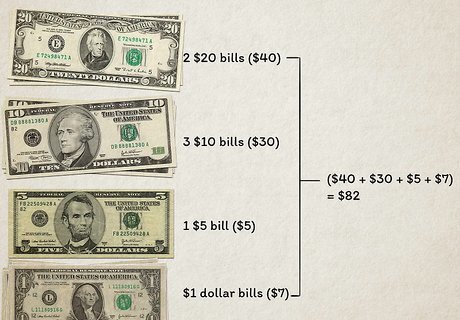
Determine the value of each pile of bills, then add the piles together. Add up your highest-value bills first, working your way down to $1 bills. The number you end up with is the total number of dollars you have. For example: Pretend you have 2 $20 bills ($40), 3 $10 bills ($30), 1 $5 bill ($5), and 7 $1 dollar bills ($7). When you add these stacks together, you get a total of $82.
Add the total of bills and coins together.
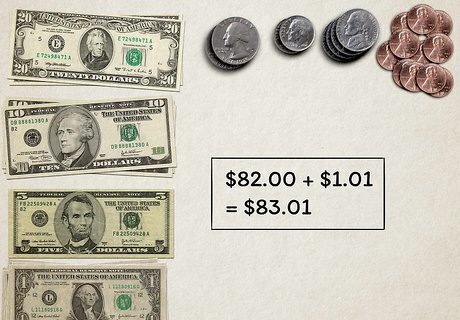
The sum of your bills and coins is the total of all your money. So far, you have $1.01 in coins and $82 in paper bills. When you add those values together, you get a grand total of $83.01! Use mental math for small numbers or numbers that are simple to add, like numbers ending in 0 or 5. Grab a calculator or do long addition with a pencil and paper to add up larger, more complicated numbers.
Skip-count to add up coins and bills faster.
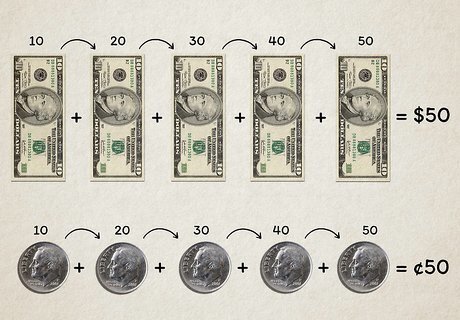
Skip-counting is the ability to count by numbers larger than 1. Since most coins and bills are worth more than 1 cent or 1 dollar, skip-counting is necessary to count them quickly and accurately. Practice skip-counting by 5s, 10s, 20s, and 25s up to the number 100 for coins, and even farther for dollar bills!. Skip-count by 5s to count nickels and $5 bills. Twenty nickels make 1 dollar: 5, 10, 15, 20, 25, 30, 35, 40, 45, 50, 55, 60, 65, 70, 75, 80, 85, 90, 95, 100. Skip-count by 10s to count dimes and $10 bills. It takes 10 dimes to make 1 dollar: 10, 20, 30, 40, 50, 60, 70, 80, 90, 100. Skip count by 20s to count $20 bills: 20, 40, 60, 80, 100. Skip-count by 25s to count quarters. It takes 4 quarters to make 1 dollar: 25, 50, 75, 100.
Use coin rolls to count large numbers of coins.
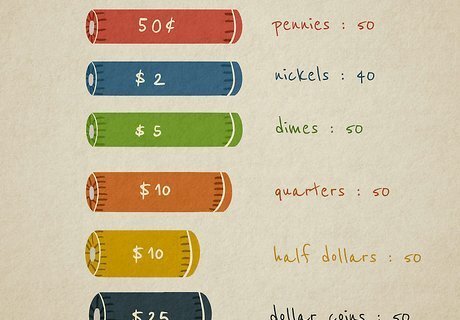
Some businesses use paper rolls to organize large amounts of coins. Each roll contains only 1 kind of coin, and the total value of the roll depends on the type of coin inside. If you have some of these, add the roll values together to find the total amount of money you have. Pennies come in rolls of 50, so each roll is worth 50 cents. Nickels come in rolls of 40, so each roll is worth 2 dollars. Dimes come in rolls of 50 (like pennies), so each roll is worth 5 dollars. Quarters come in rolls of 40 (like nickels), so each roll is worth 10 dollars. If you have large amounts of coins at home, try rolling them yourself for easy counting and storage.
Calculate change to give back with counting or subtraction.
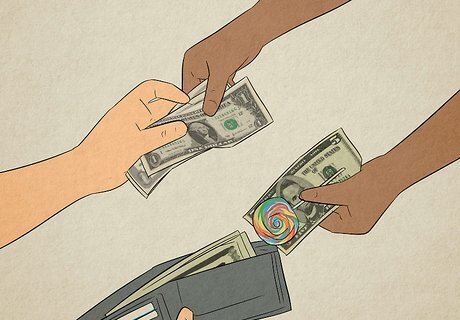
Change is what you get back after paying more than an item's cost. For example, if you buy a $3 candy bar with a $5 bill, the cashier will give you $2 worth of change since that’s the difference between what you paid and how much the bar costs. To calculate change, count forward from the cost until you reach the amount paid. In this example, count up by $1 increments from 3 to 5 to get $2. Alternatively, subtract the cost from the amount paid. In this case, 5-3 = 2, so you get $2 in change. Use whichever method is easiest for you to calculate change. Counting forward and subtracting will both get you the correct answer.










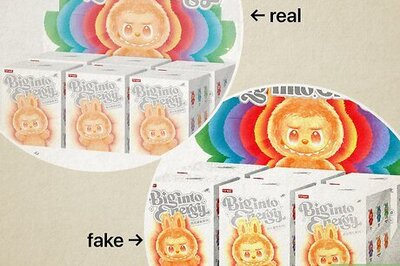


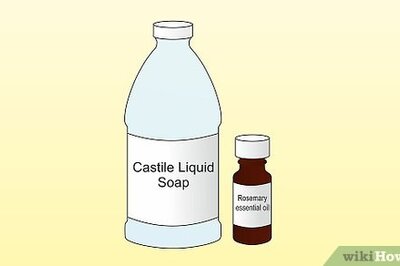






Comments
0 comment